The sun slowly disappears like a red fireball on the horizon and baobabs cast long shadows. Night falls in the land of the giants. High time for all the nocturnal creatures of this world – including baobab – to become active.
Spectacular Baobab Flowers
The trees come with a specific feature: Their FLOWERS open at NIGHT! The opening of the flower buds usually starts in the late afternoon or around sunset. The buds are green on the outside and hang like pendulums from the tree – similar to the fruit that develop later. First, the outer shell of the buds rolls up towards the stalks.
Baobab Flower Petals open in seconds
Slowly the white petals of the calyx appear from their tight sheath. Gradually the pistil (corolla tube) shows. It is slightly longer than the petals. All attention needs to be directed to the flower: once it is ready, the petals unfold within seconds – almost as one would open an umbrella! A fantastic sight. Thereafter, the inside of the flower with the stamen is visible.
- Baobab flower opening
- Baobab flower opening
- Baobab flower opening
- Baobab flower opening
- Baobab flower opening
- Baobab flower opening
- Baobab flower opening
- Baobab flower opening
- Baobab flower opening
- Baobab flower on tree
- Baobab flowers on tree
Each Baobab has own flower rhythm
Apparently, every tree has its own rhythm, in which it opens the petals. Some are very fast and need only up to 30 minutes to open – others need two hours and more. The tree I watched belongs to the latter category and was more of a “late bloomer”. Not later than the next morning the flowers are fully open.
Baobabs can grow hundreds of flower buds
Large, old baobabs can carry hundreds of flower buds. Not all open on the same day – but the ones which do open do this almost in sync – as if the tree gives a silent sign. Whether a bud opens in the evening can be seen in the afternoon – the buds swell and show a gap on their bottom side.
Baobabs are pollinated by insects
At the beginning of the opening phase, insects are busy visiting the flowers. In Zimbabwe, rose beetles can be found either enjoying nectar or nibbling the white petals. In the Venda area in Limpopo / South Africa Hawkmoth were attracted to the flowers – there they help with pollination. In other areas, bats and Bush Babies pollinate the flowers.
- Baobab flower with rose beetles
- Baobab flower with hawkmoth
- Baobab flower with hawkmoth
- Baobab flower with hawkmoth
Baobab scent is different
If one is to expect lovely fragrances of the flowers resembling that of roses or jasmine one could be disappointed. Baobab flowers exude a rather tart smell, which can be intense depending on the stage of blooming. Some compare it to the smell of carrion. I do not share this view. On my last visit to the Kruger National Park I came by a dead hippopotamus and the smell of it differed essentially from that of baobab flowers.
Baobabs flower in the rainy season
Shortly before or at the onset of the rainy season baobabs grow their leaves. Almost simultaneously the flower buds occur. About four weeks later the trees start to bloom. Most baobabs flower once a year. On the Ivory Coast, trees were observed to flower twice a year and grow fruit twice a year as well. Some baobabs do not have flowers/fruit every year.
The rainy season in Southern Africa starts around November and carries on into January. The flowering period of baobabs depends on several factors: whether the rainy season is on time, length and intensity of rainfall, altitude where the trees grow and the composition of the soils (water content).
Baobab flowers have a life cycle of one day
On average, baobabs start to flower and bear fruit at the age of about 20 years. Significant regional differences occur: In West Africa trees are said to flower at the age of eight to ten years for the first time, in Southern Africa above 20 years.
- Baobab Flower
- Baobab Flower
- Baobab Double Flower
- Baobab flower, wilting
- Fallen Baobab Flower
- Baobab flower wilting
- Wilted Baobab Flower
- Wilted Baobab Flower
- Wilted Baobab Flower
- Wilted Baobab Flower
- Fallen Fruitification
- Baobab, Sagole Big Tree
Depending on the area where the baobab grows, a baobab flower can be pollinated only for about 12 – 18 hours. In the early morning of the next day the flowers might still look pretty – but start to wilt quickly, depending on the location and prevailing temperatures. In this process the petals turn brown, slide down the pistils and fall to the ground. Goats and cattle feed on them. Within 24 hours, a flowering cycle from opening of the flower buds until the withering of the flower is completed.














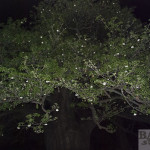

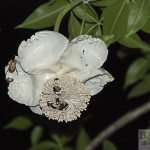







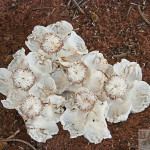
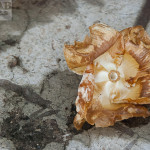





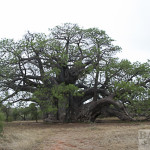
I love your article on the baobab flowers, it is so informative and all your beautiful photographs X
I also love your baobab Christmas tree – so different and original, it is so cute X
Hi Rozanne,
thanks so much for reading & commenting!!! Love it!!! 🙂
Hi,
About 17 years ago I sowed some baobab trees. The tree had one main stem. After time I witnessed the tree to uplift a branch from 40 deg. to strait up, forming a second main trunk. The whole tree tilted too. I suspect the tree can lift its branches by swelling.
The tree did not bloom yet (after 17 years). An A. gregorii of the same age, much smaller, flowered already for three years. Here in Curacao in September.
Hi Michiel, thank you for your information – that sounds interesting, indeed. Is the tree you describe Adansonia digitata?
https://www.youtube.com/watch?v=Vp83DffMJ8Y
Check this out
Hi Grant McLaney, thank you for sharing this link – impressive to watch the flowers open!
good evening, loved your article. at what stage would you pick the fruits? how long after flowering? if you wish to dry and grind into powder for example.
thank you
Hello Maxine, thank you for your positive feedback. Generally it is best to let the fruit ripe on the tree. They fall off automatically once they are ready. The tree withdraws the water from the fruit and recycels it into its system and if the powder can dry naturally it does not get fungus so easy. If you handpick the fruit, they might have too much moisture inside. From a ripe fruit all you have to do is extract the powder and sieve it. Then you can consume the powder. All the best, Heike
Can u buy one of those baobab flower
Hello Effie, thank you for your comment. I am afraid one cannot buy baobab flowers – they blossom for one night only and by next morning they wilt. Best regards, Heike
very interesting article. What a special tree.
Thank you very much for your comment – yes, baobabs are special trees, indeed 🙂
Hi, is there a kind of baobab tree, that flowers every 50 years ?
Hi Francisca, thank you for your interest in Baobab and their flowering. Those baobabs that I know of – for example Adansonia digitata – flower regularly and usually once a year – but it depends on different factors. Some might have a flowering “gap” if the environmental circumstances do not allow it – for example lack of water and then maybe for a year or two – if the tree itself survives. But I have never heard of baobabs only flowering every 50 years. They might reproduce successfully only every 50 to 100 years because they need the right circumstances to do so. This is called episodic recruitment but does not necessarily have to do with flowering. It means that seeds germinating survive the first three years successfully.
Hope that helps. Best regards, Heike
hi sir, when will be the first flower of this tree will come? like you said first fruit starts after 20 yrs.
Dear Mannan, thank you for your inquiry – I do not understand your question. Can you explain what you’d like to find out? Kind regards, Heike
Hello, I loved the article. I’m writting from Brazil, and I have a 18 years old baobob, a gift from a friend who lived in Angola, and I would like to know if I can do the pollination by myself (using for example cotton swabs) if the natural pollinators here couldn’t do it by themselves. I hope it blooms soon cause I would love to bear fruits. Thanks a lot. Hugs.
Hi Marco, thank you for your inquiry regarding pollination. Yes, you can try with cotton swabs – although I have to add I am not sure whether you will be successful with self-pollinating the flowers and to what extent. Scientists have found out that a baobab has male and female parts in the flowers but that they need the pollen from another baobab to successfully grow good and reasonably sized fruit. Nevertheless, it is worth giving it a try once your baobab flowers… Good luck & all the best! Heike
Pingback: Baobab – Afrika ikonikus életfája « ReBella
Hello Heike,
Since meeting you on the KAZA press trip, I often re-visit your website for specific baobab information, like how long the flower lasts. Your passion for baobabs is a wonderful focus for your travels and I hope we bump into each other staring up at a giant baobab one day.
Very best wishes Carrie in Cape Town
I now have a new website http://www.carriehamptontravelwriter.com and when i have time I’ll do a baobab post and link to your fantastic website.
Hi Carrie, thanks for getting in touch & wow, that would be nice to see a piece about baobab on your website. Do you take content from others? Kind regards, Heike